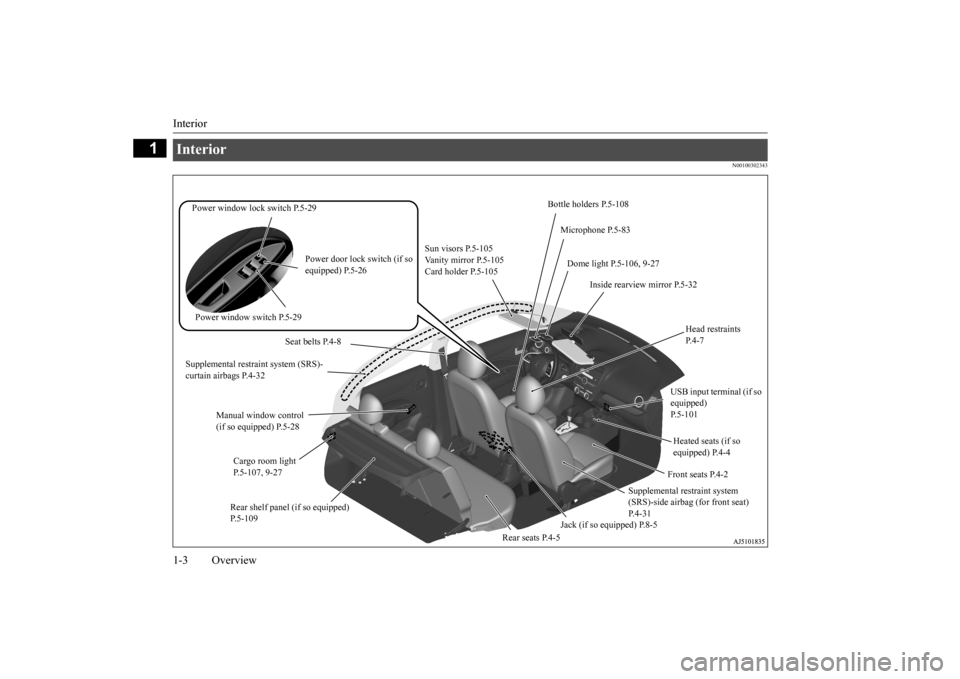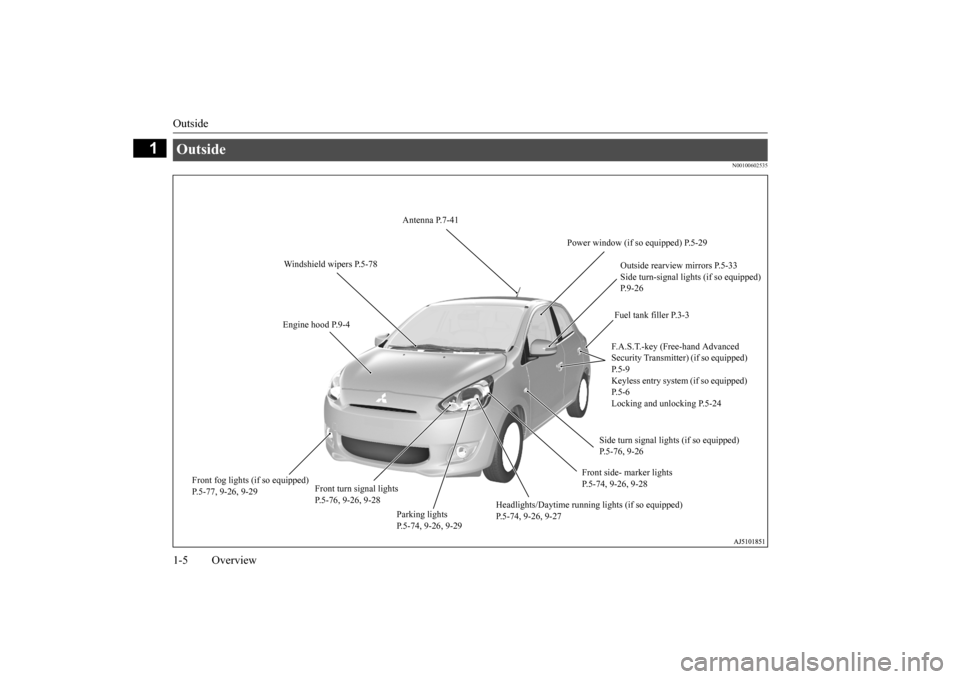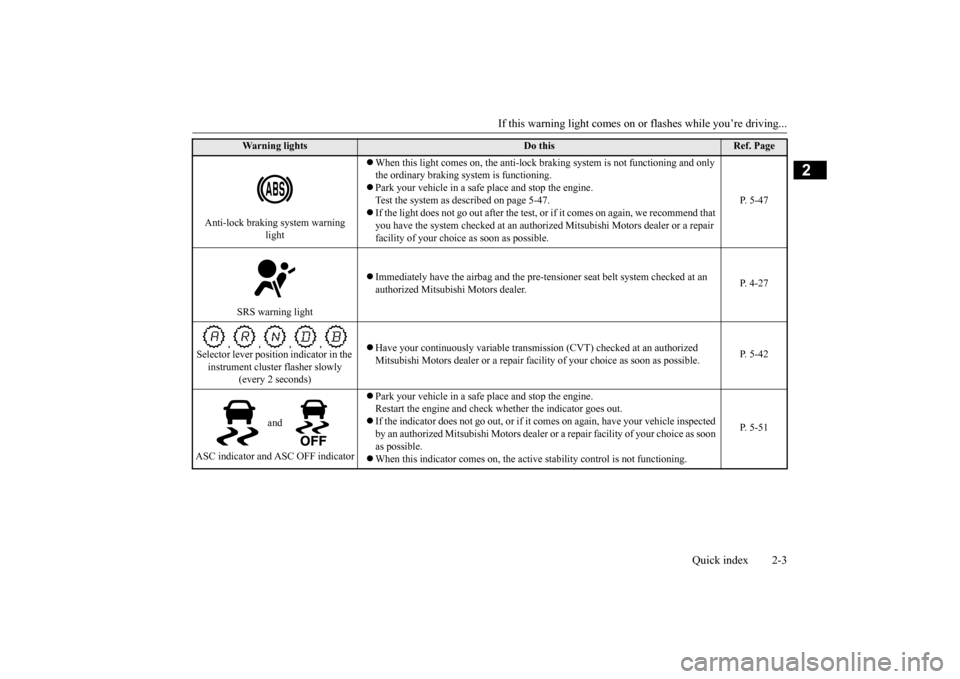2015 MITSUBISHI MIRAGE lock
[x] Cancel search: lockPage 4 of 300

Instruments and controls
Overview 1-2
1
Center vents P.7-2
Supplemental restraint system (SRS)-air- bag (for front passenger) P.4-21, 4-27
Heater (if so equipped) P.7-4 Manual air conditioning (if so equipped) P.7-7
Audio (if so equipped) P.7-18 Mitsubishi Multi Entertainment System (if so equipped) Refer to the separate “Mitsubishi Multi Entertainment System owner’s manual” Clock (if so equipped) P.7-24
Electric rear window defogger switch P.5-80 Automatic air conditioning (if so equipped) P.7-11
Side vents P.7-2
Glove compartment P.5-108
Engine hood release lever P.9-4
Cup holder (for the front seat) P.5-108
12 V power outlets P.5-106
Electric rear window defogger switch P.5-80
Key slot (if so equipped) P.5-20
Gearshift lever (if so equipped) P.5-38 Selector lever (if so equipped) P.5-39
Fuel tank filler do
or release lever
P. 3 - 3
Parking brake lever P.5-31
Cup holder (for the rear seat) P.5-108
BK0212400US.book 2 ページ 2014年4月1日 火曜日 午後2時21分
Page 5 of 300

Interior 1-3 Overview
1
N00100302343
Interior
Bottle holders P.5-108
Power window lock switch P.5-29
Microphone P.5-83
Sun visors P.5-105 Vanity mirror P.5-105 Card holder P.5-105
Power door lock switch (if so equipped) P.5-26
Dome light P.5-106, 9-27
Inside rearview mirror P.5-32
Head restraints P. 4 - 7
Power window switch P.5-29
Seat belts P.4-8
Supplemental restraint system (SRS)- curtain airbags P.4-32
USB input terminal (if so equipped) P.5-101
Manual window control (if so equipped) P.5-28
Heated seats (if so equipped) P.4-4
Cargo room light P.5-107, 9-27
Front seats P.4-2
Supplemental restraint system (SRS)-side airbag (for front seat) P.4-31
Rear shelf panel (if so equipped) P.5-109
Jack (if so equipped) P.8-5
Rear seats P.4-5
BK0212400US.book 3 ページ 2014年4月1日 火曜日 午後2時21分
Page 7 of 300

Outside 1-5 Overview
1
N00100602535
Outside
Antenna P.7-41
Power window (if so equipped) P.5-29
Windshield wipers P.5-78
Outside rearview mirrors P.5-33 Side turn-signal lights (if so equipped)P.9-26 Fuel tank filler P.3-3
Engine hood P.9-4
F.A.S.T.-key (Free-hand Advanced Security Transmitter) (if so equipped) P. 5 - 9 Keyless entry system (if so equipped) P. 5 - 6 Locking and unlocking P.5-24
Side turn signal lights (if so equipped) P.5-76, 9-26
Front side- marker lights P.5-74, 9-26, 9-28
Front fog lights (if so equipped) P.5-77, 9-26, 9-29
Front turn signal lights P.5-76, 9-26, 9-28
Headlights/Daytime running lights (if so equipped) P.5-74, 9-26, 9-27
Parking lights P.5-74, 9-26, 9-29
BK0212400US.book 5 ページ 2014年4月1日 火曜日 午後2時21分
Page 12 of 300

If this warning light comes on or
flashes while you’re driving...
Quick index 2-3
2
Anti-lock braking system warning
light
When this light comes on,
the anti-lock braking system
is not functioning and only
the ordinary braking system is functioning. Park your vehicle in a safe
place and stop the engine.
Test the system as described on page 5-47. If the light does not go out after
the test, or if it comes on
again, we recommend that
you have the system checked at an authorized
Mitsubishi Motors dealer or a repair
facility of your choice
as soon as possible.
P. 5-47
SRS warning light
Immediately have the airbag and the pre-te
nsioner seat belt sy
stem checked at an
authorized Mitsubishi Motors dealer.
P. 4-27
Selector lever position indicator in the instrument cluster flasher slowly
(every 2 seconds)
Have your continuously variable transmis
sion (CVT) checked at an authorized
Mitsubishi Motors dealer or
a repair facility of your
choice as soon as possible.
P. 5-42
and
ASC indicator and ASC OFF indicator
Park your vehicle in a safe
place and stop the engine.
Restart the engine and check
whether the indicator goes out.
If the indicator does not go out, or if it
comes on again, have
your vehicle inspected
by an authorized Mitsubishi Motors dealer or
a repair facility of your choice as soon
as possible. When this indicator comes on, the activ
e stability control is not functioning.
P. 5-51
Wa rn in g l ig h t s
Do this
Ref. Page
BK0212400US.book 3 ページ 2014年4月1日 火曜日 午後2時21分
Page 14 of 300

If this problem occurs...
Quick index 2-5
2
N00200900870
If this problem occurs...
Problem
Do this
Ref. Page
Unable to turn the key. (except for vehicles equipped with the F.A.S.T.-key)
From “ACC” to “OFF” Vehicles with cont
inuously variable
transmission (CVT):
Check the position of the selector lever. The key cannot be removed unless the selector
lever is set to the “P” (PARK) position.
P. 5-35
The engine does not start when the engine switch is pressed. (for vehicles equipped with the F. A . S . T. - k e y )
Make sure the F.A.S.T.-key is in the vehicle. Vehicles with ma
nual transaxle:
Press and hold the clutch pedal all the way dow
n, and then press the
engine switch while
depressing the brake pedal. Vehicles with cont
inuously variable
transmission (CVT):
Make sure the selector lever is in the “P” (P
ARK) position, and then press the engine switch
while depressing the brake pedal.
P. 5-16
The F.A.S.T.-key does not oper- ate. (for vehicles equipped with the F. A . S . T. - k e y )
Use the emergency key to lock and unlock the door. Insert the F.A.S.T.-key into the key slot of th
e floor console, and then start the engine or
change the operation mode.
P. 5-19
BK0212400US.book 5 ページ 2014年4月1日 火曜日 午後2時21分
Page 21 of 300

Filling the fuel tank 3-4 General information
3
9.2 gal (35 L) 1. Before filling with
fuel, stop the engine.
2. The fuel tank filler is located on the reardriver side of your vehicle. The fuel tank filler door can be opened from inside the vehicle with the fuel tank filler door releas
e lever located at the left
side of the driver’s seat. 3. Open the fuel tank filler pipe by slowly turning the fuel tank filler cap counter- clockwise.
4. While filling with fuel, hang the fuel tank filler cap cord on the hook located on theinside surface of the fuel tank filler door.
5. To fill with fuel correctly depends mainly on correct handling of the fuel filler noz- zle. Do not tilt the nozzle. Insert the noz- zle in the fuel tank filler port as far as itgoes. 6. When the nozzle stops automatically, do not add more fuel.
Fuel tank capacity Refueling
1- Remove 2- Close
WA R N I N G Since the fuel system may be under pres- sure, remove the fuel tank filler capslowly. This relieves
any pressure or vac-
uum that might have built up in the fuel tank. If the fuel tank filler cap is venting vapor or if you hear
a hissing sound, wait
until the sound stops before removing the fuel tank filler cap. Otherwise, fuel may spray out, injuring you or others.CAUTION Your vehicle can onl
y be operated using
unleaded gasoline. Seri
ous engine and cata-
lytic converter
damage will result if leaded
gasoline is filled into these vehicles, and consequently, this must
never be attempted.
BK0212400US.book 4 ページ 2014年4月1日 火曜日 午後2時21分
Page 22 of 300

Modifications to and racing of your vehicle
General information 3-5
3
7. To close, turn the fuel tank filler cap slowly clockwise un
til you hear clicking
sounds, then gently push the fuel tankfiller door closed.
N00301600194
This vehicle should not be modified withnon-Mitsubishi Motors genuine parts. Mitsubishi Motors designs and manufactures high quality vehicles
with an emphasis on
safety and durability.
Modifications using
non-Mitsubishi Motors genuine parts may affect the performance, safety and/or durabil-ity of your vehicle,
and may violate applica-
ble state and/or fe
deral regulations.
DAMAGE OR PERFORMANCE PROB- LEMS RESULTING FROM MODIFICA-TIONS TO OR RACING OF YOUR
VEHICLE ARE NOT COVERED UNDER WARRANTY. Examples of modifications to your vehicle that can cause damage or performance prob- lems include the following: Failure to use Mits
ubishi Motors genuine
parts Failure to use required fuel and fluids Failure to use proper
size tires and wheels
Modification of the fu
el, intake, exhaust,
emission, suspension,
engine, drive train
or electrical wiring systems Modification of any onboard com- puter/control module, including repro- gramming, or replac
ing/adding chips to
any onboard computer/control module
Review the Warranty
and Maintenance Man-
ual for further details
regarding warranty cov-
erage.
N00301700212
CAUTION To avoid fuel spillage
and overfilling, do not
“top-off” the fuel tank. Spilled fuel coulddiscolor, stain, or cr
ack the vehicle’s paint-
work. If fuel spills on the paintwork, wipe it off with a soft cloth.WA R N I N G Make sure the fuel tank filler cap is securely closed. If the fuel tank filler cap were loose, fuel coul
d leak, resulting in a
fire.CAUTION If you need to replace the fuel tank filler cap, use only the fuel tank filler cap specified for your model vehicle.
NOTE
If the fuel tank filler cap is not tight while driving, the engine
malfunction indicator
(“SERVICE ENGINE SOON” or “Checkengine light”) may come on when the onboard diagnostic (OBD) system performs a self check.Always tighten the fu
el tank filler cap until
you hear at least 3 clicks. The indicator will go of
f after several driving
cycles. If the indicato
r does not go off, con-
tact your authorized
Mitsubishi Motors
dealer or a repair faci
lity of your choice as
soon as possible.
Modifications to and racing of your vehicle
Installation of accessories
CAUTION Before any electrical or electronic accesso- ries are installed,
consult an authorized
Mitsubishi Motors dealer.
BK0212400US.book 5 ページ 2014年4月1日 火曜日 午後2時21分
Page 27 of 300

Seats 4-2 Seat and restraint systems
4
N00408400509
To adjust the seat forward or back- ward
Page 4-3
To adjust the seatbacks
Page 4-3
To adjust the seat height (Driver’s seat only, if so equipped)
Page 4-4
Heated seats (if so equipped)
Page 4-4
Folding the seatbacks forward
Page 4-6
N00401600212
Your vehicle has seat
belts and other safety
features that help
protect you and your pas-
sengers in an accident.Seat belts are the most important safety device. When worn properly, seat belts can reduce the chance of serious injury or deathin various types of cras
hes. For added protec-
tion during a severe fr
ontal collision, your
vehicle has a Supplemen
tal Restraint System
(SRS) with airbags for the driver and passen- gers. The seats, head restraints, and door
locks also are safety equipment, which must be used correctly. Always check the following before you drive: That everyone in your vehicle is properly wearing their seat belt. That infants and small children are prop- erly secured in an appropriate childrestraint system in the rear seat. That all doors are fully closed and locked. That seatbacks are upright, with head restraints properly adjusted.
Seats 1 - Front seats 2 - Rear seats
Seats and restraint systems
BK0212400US.book 2 ページ 2014年4月1日 火曜日 午後2時21分